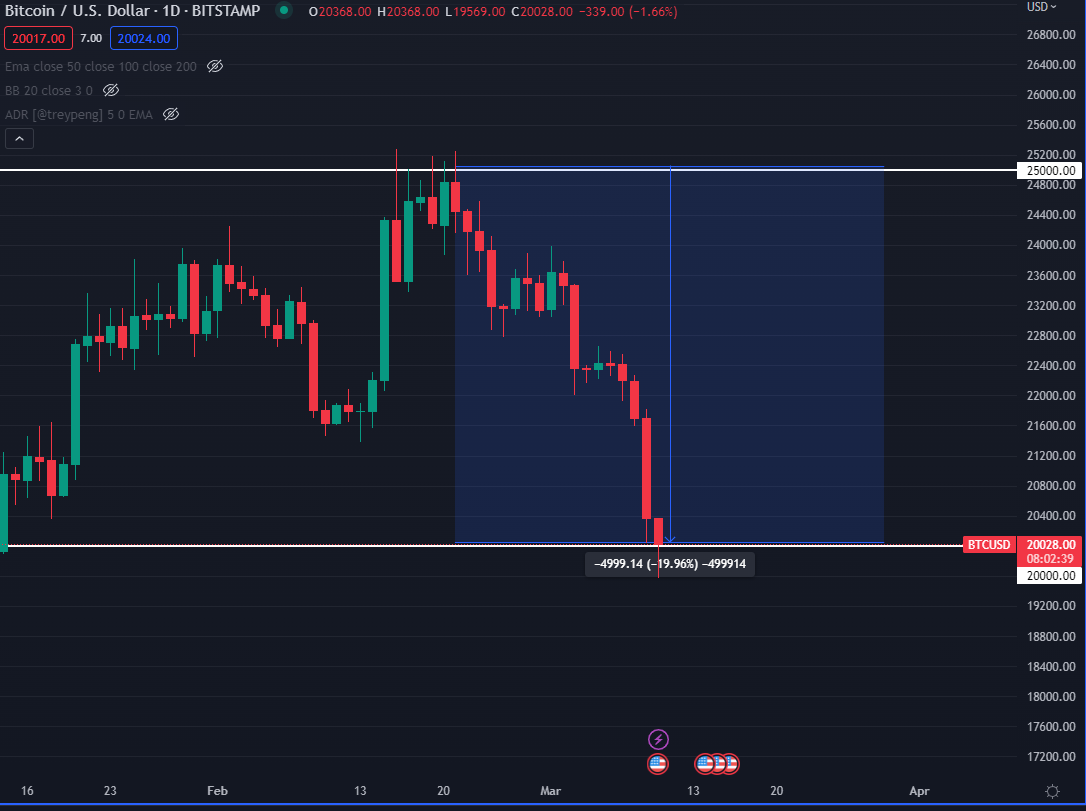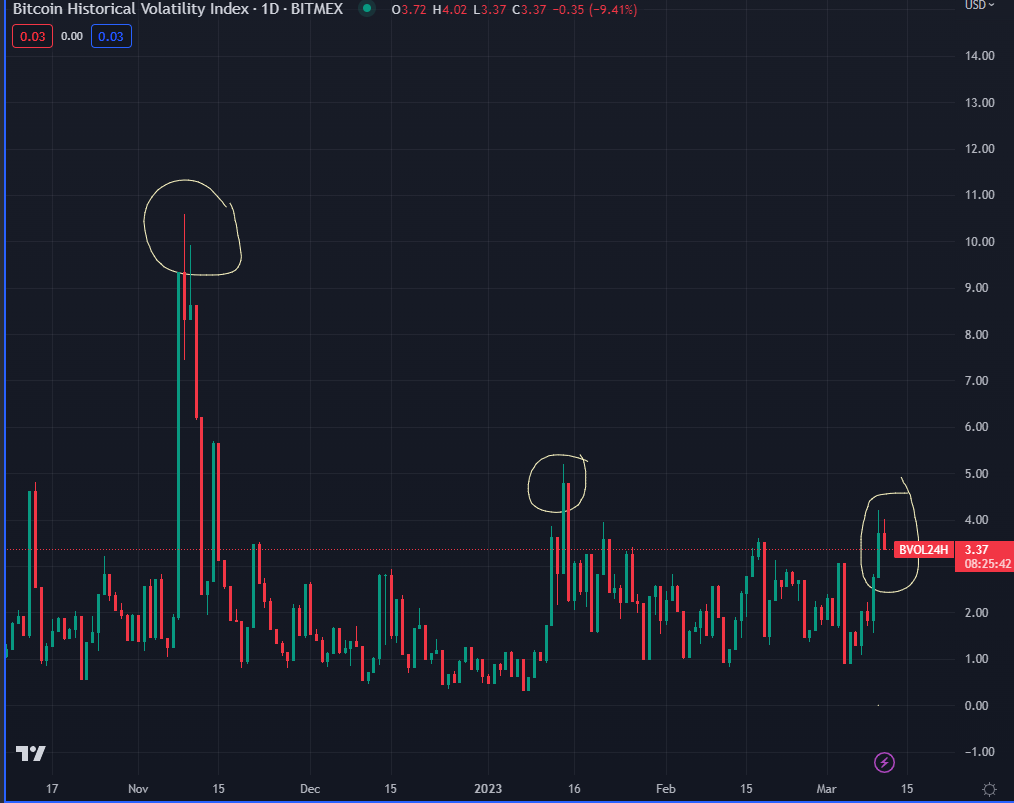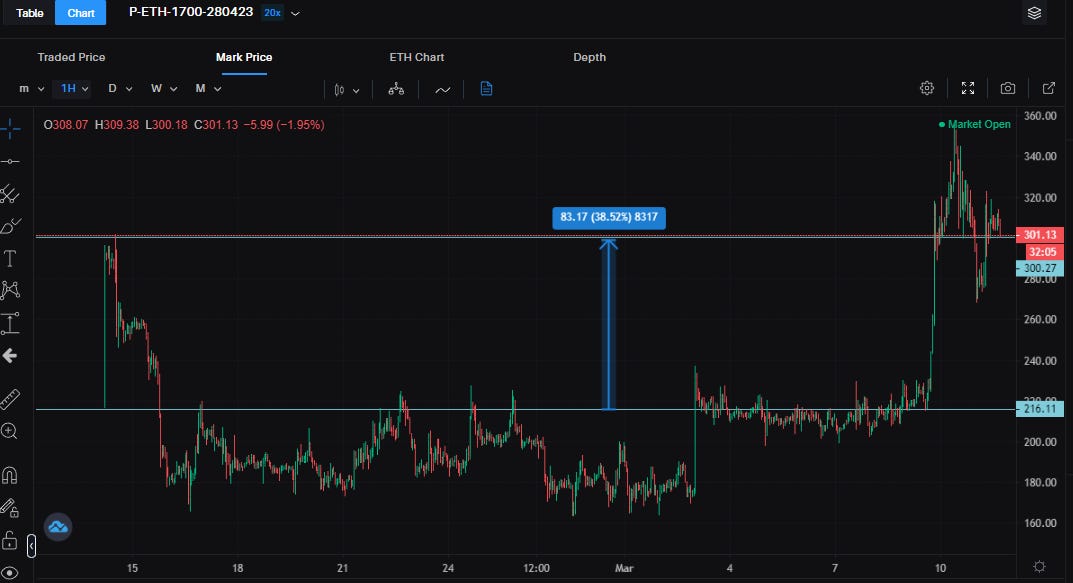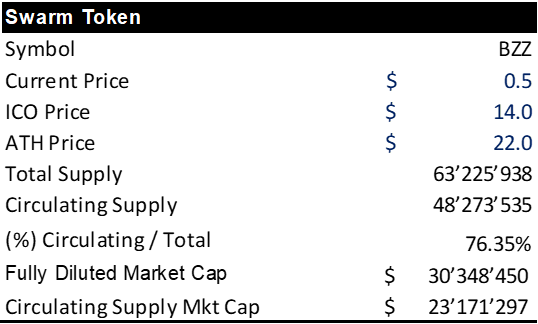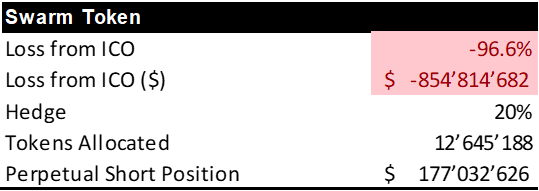Volatility Risk in the Market? Read, you might be interested in
How to protect your Digital Assets from tail events and survive the bear market
Writing this post would never have been more timely. Algo Capital's research team spends countless hours monitoring the market and talking to investors and founders. Based on these observations and discussions, we have identified a significant gap in the approach to risk of many cryptocurrency market participants. We’ll show you how we plan to help investors and founders protect their funds from rising volatility.
Bitcoin has just failed to pass over the $25k option level resistance at the end of February 2023, and a pronounced drop of -20% in Bitcoin’s price ensued last week. In just a matter of days, Bitcoin retraced to the $20k option level. Altcoins, had an even more pronounced decline given the higher betas.
Source: TradingView
As most participants in this market have discovered of late, investing in digital assets can be like riding a rollercoaster. You experience moments of exhilarating highs, followed by stomach-churning drops. As a crypto fund manager or founder of a web 3.0 company, managing a portfolio or a treasury balance in this highly volatile environment can be a daunting task. Just as a skilled roller coaster rider anticipates the twists and turns, you must always be vigilant and make sure to avoid the mistakes that you can’t recover from.
Like we just experienced, sudden changes in price volatility can lead to significant losses for all market participants, making it essential to have risk management policies in place that can protect you from large drawdowns. The majority wasn’t addressing these risks properly, if not at all, as the bull market was raging and people threw caution out of the window.
This post explores the importance of defending your assets during critical moments, provides effective hedging strategies, discusses challenges and risks in the cryptocurrency market, and highlights the benefits of this risk management strategy. By understanding the importance of hedging, we want to help crypto funds and founders better protect their investments and increase their chances of long-term success.
Volatility:
Volatility is the name of the game in digital assets. Cryptocurrencies are known for their wild swings in price, and this can be a double-edged sword for investors. While volatility can lead to significant gains, it can also result in losses.
Recent events are a perfect example of that. The fall of Silvergate and Silicon Valley Bank, as well as a high rates and inflation backdrop, were conductive to another large negative volatility event in the past week:
Source: Trading View
Market participants should always keep a close eye on this important indicator and be ready to act to protect their assets when appropriate.
Just in the short period illustrated in the Bitcoin Historical Volatility Chart above, from November 2022 to March 2023, there have been three large increases in volatility which have coincided with a sharp drops in prices. Those that were able to carefully manage their risk profile during those events, would have been able to safely weather the storm. On the other hand, many have suffered great losses due to their disregard of sound risk management policies.
With this post, we want to share with you some straightforward methodologies to better manage your portfolio in the future.
Risk Management 101: Hedging
There are many ways in which you can safeguard your assets from an ensuing market crash. One of the most flexible strategies is Hedging.
Hedging involves taking positions in the market that offset the risk of your other positions. For example, an investor or a founder might use derivatives such as options or futures contracts to hedge against volatility. This can help to protect their portfolios from large losses while still allowing them to participate in the upside potential.
Hedging is like wearing a safety harness on a rollercoaster ride. It won't prevent the ups and downs, but it can help protect you from the worst of them. By strategically placing trades, hedging allows one to minimize risk and potentially turn a profit, even in the midst of market turbulence.
In these critical moments, such as a market crash or significant regulatory changes, hedging can be especially important to protect your assets. For example, if a new regulation is introduced that negatively impacts digital assets, hedging can help investors reduce their exposure and limit the potential losses.
For traditional early-stage funds and entrepreneurs, hedging has never been a major concern. However, tokens are publicly traded from day one and 24/7, which increases exposure to market sentiment and manipulation, making sound risk management frameworks through hedging essential.
Let’s see some basic strategies to hedge your portfolio with some real life examples taken from the past week in the markets.
Strategies for Crypto Funds:
Crypto funds have several options when it comes to protecting their portfolios from downside risks. These include:
Options Contracts: Options contracts can provide funds with the ability to buy or sell a particular cryptocurrency at a predetermined price in the future. This can help hedge against potential losses if the price of the cryptocurrency drops.
Perpetual Futures: Futures are similar to options contracts in that they allow funds to lock in a future price for a cryptocurrency. This can help protect against market volatility and provide funds with more predictable returns.
Diversification: Diversification is a strategy that involves investing in a variety of assets across different sectors, industries, and geographic regions. By diversifying your portfolio, you can reduce your exposure to any one asset or market and hedge against market volatility. Digital assets are highly correlated, adding other assets to your portfolio could be paramount for your overall performance.
The Money Manager Case Study:
To better understand how these strategies work in practice, let's look at a specific example.
Suppose you are a fund manager concerned about the potential impact of negative volatility on your portfolio of tokens worth $10,000,000 (equal weights).
You have correctly predicted the upcoming drop in prices by observing that there was excessive exuberance at the end of February, and you started to get worried that the bulls were overextending. Spotting this weakness, you decided to hedge your portfolio by purchasing Put Options in amounts equal to 30% of your portfolio.
You are aware that Put Options are at their cheapest during bull trends, because none expects the music to stop – this is the perfect buying opportunity.
Let’s see what unfolds in two scenarios after a significant market drop, one where the portfolio isn’t hedged, and the other one when the portfolio is hedged:
SCENARIO #1 - Naked Portfolio
In this scenario, as showcased in the table below, tokens prices have declined significantly, which is not mitigated in any way - there is no risk management strategy in place. Ethereum’s price dropped as well, but was more resilient than the other tokens, moving from $1,700 to $1,400.
Source: Algo Capital
The overall loss incurred, if you didn’t purchase a hedge, was around - 33% of the entire portfolio, or $3,386,150. This is a hard hit, which could be even more pronounced if you had leveraged your positions.
SCENARIO #2 - Hedged Portfolio
If we take the more conservative approach, we would have wanted to hedge 30% of the portfolio, so around $3,000,000. We would have had to pay the corresponding amount of premium by acquiring Put Options on Ethereum.
We could have purchased contracts with a strike price of $1,700, expiring on the 28th of April 2023 for $200 per contract around the end of February, when the market was experiencing a contraction in volatility and prices were still elevated.
To hedge 30% of our portfolio, we would have had to buy 15,000 contracts which would have come to about $3,000,000 in premium.
The ensuing - 15% drop in Ethereum price from $1,700 to $1,400 would have given us the opportunity to sell our Put Contracts on the market around the 10th of March for $324 per contract.
Source: Delta Exchange
The chart above showcases the actual rise in premium of the Ethereum Put Options, which gained around 38%. As the negative volatility increased, so did the implied volatility embedded in the option contracts elevating their value.
This hedging strategy would have netted us:
Premium paid (-$3,000,000) + Profit on Put Options ($4,860,000) = Net Profit ($1,860,000)
Hedged Portfolio ($): $6,673,850 + $1,500,000 = $8,533,850
The hedged portfolio performed significantly better, dropping only -15% against the -33% achieved by the naked portfolio. In this example, our hedging strategy was able to soften the blow of the sharp drawdown. This cushion could have been critical for us to take advantage of new opportunities in the depressed prices environment, having almost $2,000,000 of capital to invest in bargains.
At Algo Capital, we have extensive experience working with clients on the buy side by providing them with accurately designed hedging packages that can meet even the most complex demands.
If you are a fund manager that has been hurt by the recent downturn, you should be proactive and improve your risk management policies as soon as possible. Don’t get caught up in the next cycle again. Book a call with us and let us help you protect your portfolio.
Strategies for Crypto Founders:
Let’s now look at what Crypto founders could do to better risk manage their treasury. They can also take steps to protect against downside risks. These include:
Creating a buyback program: A buyback program can help stabilize the price of a company's token by committing to buying back tokens if the price drops below a certain level.
Token burning: Token burning is the process of removing a certain number of tokens from circulation, which can help reduce supply and potentially increase the token's price.
Derivatives contracts: Hedging the treasury with a specific hedging strategy using perpetuals or options could prevent a wipeout of the company's assets as well as helping the company better manage their reserves.
The Swarm Case Study:
There are plenty of ways in which a company could take advantage of hedging to protect their balance sheet. A mistake we see most of the time in the market is an incorrect estimation of the token price at launch as well as a lack of implementation of strategies to reduce the volatility of the treasury.
Digital assets companies often have to meet expenses in FIAT currency or in other currencies like Ethereum and Bitcoin. They sometimes fail to properly match the different volatilities of the assets and liabilities on their balance sheet, ultimately causing them to go bust.
Furthermore, if a founder has launched the ICO during a bull market, they might have priced it too high given the exuberance, but were then blindsided when negative volatility ensued. Failing to account for a potential downturn, has put many founders in precarious situations, making them scrambling to raise new rounds from investors.
Let’s look at a real example of a project we selected, the SWARM ($BZZ) token of the Swarm Ecosystem.
The following table showcases some relevant data:
Source: CoinMarketCap
We can observe how the BZZ token has lost considerable amount of value since its launch in June 2021. Founders and investors in this project got almost wiped out, if you consider that the BZZ token is down - 96.6% on the day and they lost the equivalent of $854,814,682.
Almost a billion in valuation vanished ! Could this catastrophe have been avoided ?
Certainly so. Through a simple hedge, the founders and investors in BZZ would have saved hundreds of millions of dollars. Let’s see how we could have applied a simple hedging strategy with perpetual futures to this token:
In this example, let’s imagine Swarm has negotiated a contract with an exchange or an OTC third party creating an ad doc future contract on the BZZ token. Swarm has taken 20% of their Treasury tokens, worth around $177,032,626 at ICO price, and sold an equivalent amount of future contracts short on the market.
The following table reports the results of this hedging strategy:
Source: Algo Capital
Selling short the future contracts would have ensured that that portion of the supply remained basically fixed at the ICO price of $14. In other words, the future contracts would have counterbalanced the loss in the token price, which went from $14 at ICO to $0.5. The same 20% of Treasury would have been worth only ~ $6m today, which means that the founders and investors could still have $170,962,626 in their pockets.
The Swarm Network could have been worth 4x more than what it’s worth today.
Note:
Of course, it would be possible to hedge the treasury also by selling short a perpetual contract on another asset like Ethereum - if there’s no possibility to create an ad hoc contract. The hedging strategy won’t be as effective as the assets aren’t 100% correlated, but it would still ensure that Swarm would have survived the onslaught.
Our hedging strategists at Algo Capital have created tailored hedging solutions for crypto companies.
From designing the right hedging contracts to our timing signal service suite, we can help you be ahead of the market and avoid risk of ruin. Get in touch !
Benefits & Risks
As we’ve seen with the examples above, by offsetting the impact of unfavorable market movements, hedging can protect against potential losses, providing greater financial stability and improving confidence in decision-making.
The benefits of hedging include reducing risk, stabilizing cash flow, and protecting profits from external risks. However, hedging also comes with risks that need to be carefully considered.
One significant risk is the opportunity cost of hedging. In some cases, the cost of the hedge may outweigh the potential benefits, resulting in missed profits if the market moves in a favorable direction. Therefore, it is essential to weigh the costs and benefits of hedging and make informed decisions. Another significant risk of hedging is complexity. Hedging can be a complex process that requires expertise and resources to implement effectively. It may require the assistance of specialized professionals to execute. This complexity can make it challenging for businesses to implement hedging strategies effectively by themselves if they lack the internal expertise.
Finally, hedging strategies can sometimes fail to provide adequate protection against market risk. If the market movements are more significant than anticipated, the hedge may not provide sufficient protection, resulting in financial losses. Therefore, it is essential to assess the effectiveness of hedging strategies regularly and make adjustments as necessary to ensure adequate protection against market risks.
In summary, while hedging can be a valuable strategy for reducing risk and improving financial stability, it is crucial to weigh the costs and benefits carefully and to consider the potential risks associated with hedging. By doing so, businesses can make informed decisions about when and how to implement hedging strategies effectively.
Don’t let volatility catch you off guard again !
The Algo Team



